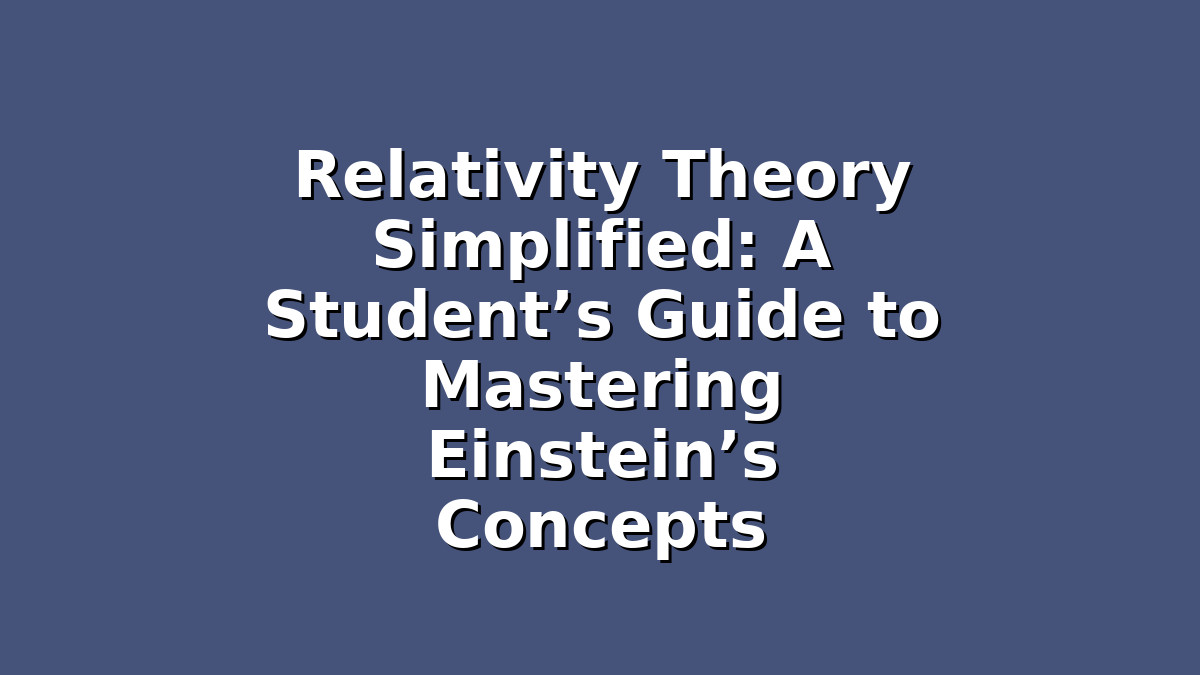Introduction
If you’re a student preparing for exams and find yourself staring blankly at the words “Relativity Theory,” you’re not alone. Albert Einstein’s theory of relativity can seem intimidating at first glance, full of complex formulas and abstract ideas. But with the right approach and study techniques, understanding this fascinating topic becomes much more achievable. This article will break down the basics of relativity theory into simple terms and provide you with practical study tips to help you grasp and retain the concepts, so you can confidently tackle your exams.
Section 1: Understanding the Basics of Relativity Theory
Relativity theory is actually made up of two parts: Special Relativity and General Relativity. Special Relativity, introduced by Einstein in 1905, deals with objects moving at constant speeds, especially those moving close to the speed of light. General Relativity, published in 1915, expands the theory to include gravity and acceleration.
The key idea behind Special Relativity is that the laws of physics are the same for all observers moving at constant speeds relative to each other. This leads to surprising conclusions such as time dilation (time moving slower for someone moving close to the speed of light) and length contraction (objects appearing shorter in the direction of motion). General Relativity, on the other hand, describes gravity not as a force but as the bending of spacetime caused by mass and energy.
To master these ideas, start by visualizing them with everyday analogies. For example, imagine a train moving at high speeds to understand time dilation — a clock on the train ticks slower compared to a clock standing still on a platform. Visual aids like diagrams and animations can also make these abstract concepts more tangible.
Study Tip: Create summary notes with simple definitions and diagrams for each key concept. Don’t just memorize formulas; focus on what they mean and why they’re important.
Section 2: Breaking Down the Math in Relativity
Math is often the stumbling block for many students when it comes to relativity. The good news is that you don’t need to be a math genius to understand the core concepts. However, becoming comfortable with the math involved can deepen your understanding and help you solve exam problems with confidence.
Start with the fundamentals: understand the concept of spacetime, which combines three dimensions of space and one dimension of time into a four-dimensional continuum. Learn about events (points in spacetime) and how their coordinates change depending on the observer’s frame of reference.
Next, focus on the Lorentz transformations—these are the mathematical formulas that relate time and space coordinates between different inertial frames (observers moving at constant speeds relative to each other). Practice simple problems that use these transformations to calculate time dilation and length contraction.
For General Relativity, the math becomes more advanced, involving tensors and differential geometry. Unless your exam requires it, focus on the qualitative understanding of how gravity bends spacetime rather than the complex calculations.
Study Tip: Work through practice problems step-by-step, and don’t hesitate to use online resources or study groups to clarify difficult math concepts. Repetition is key to building confidence.
Section 3: Effective Study Strategies for Relativity Theory
Relativity theory can be dense, so having a strong study plan is crucial. Here are some proven methods to optimize your learning:
1. Active Learning: Instead of passively reading your textbook, engage actively by summarizing what you read, teaching the concept to a friend, or drawing concept maps. Explaining ideas aloud helps solidify your understanding.
2. Use Multiple Resources: Supplement your textbook with videos, animations, and interactive simulations. Websites like Khan Academy, YouTube channels dedicated to physics, and free online courses can offer different perspectives that might resonate better with you.
3. Regular Review: Spaced repetition — revisiting material multiple times over days or weeks — helps move information from short-term to long-term memory. Schedule quick daily reviews of key concepts, then revisit more challenging topics weekly.
4. Relate to Real Life: Try to connect the theory to real-world applications. For example, GPS satellites must correct for time dilation effects predicted by relativity to provide accurate location data. Understanding these connections can make the material more interesting and memorable.
5. Practice Exam Questions: Applying your knowledge under exam conditions helps identify weak spots and builds exam confidence. Use past papers or sample questions to test yourself.
Study Tip: Set achievable study goals for each session and reward yourself when you meet them. Staying motivated is just as important as studying hard.
Conclusion
Relativity theory might seem complex, but with patience, the right approach, and effective study strategies, it becomes accessible and even exciting. Start by understanding the basic concepts and their significance, gradually build your mathematical skills, and use active learning methods to deepen your comprehension. Remember, consistency is key — regular review and practice will prepare you well for your exams. Keep a positive mindset, and don’t hesitate to seek help when needed. Soon, you’ll find yourself not only understanding relativity theory but appreciating the remarkable ideas that have shaped modern physics.

Responses